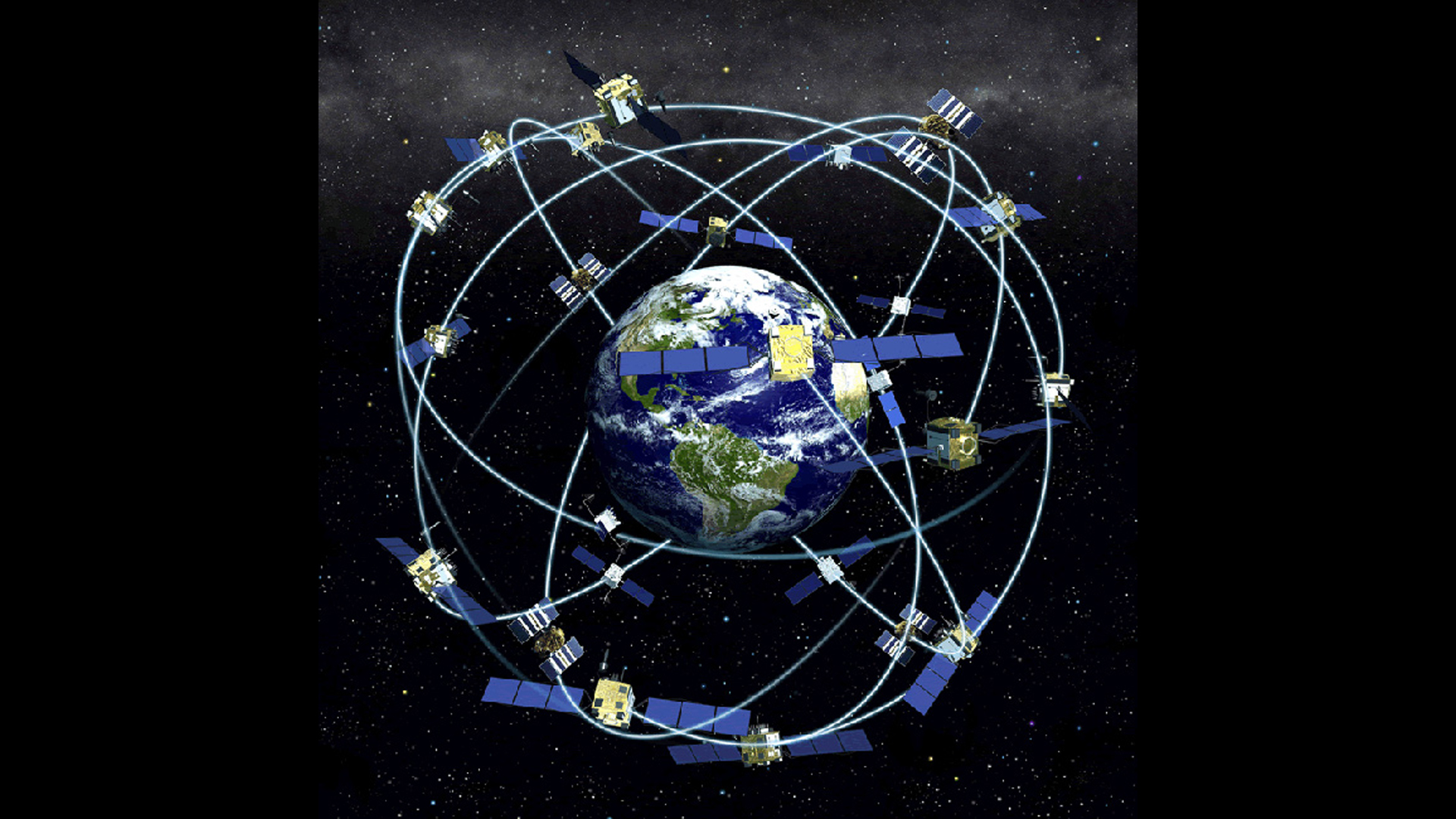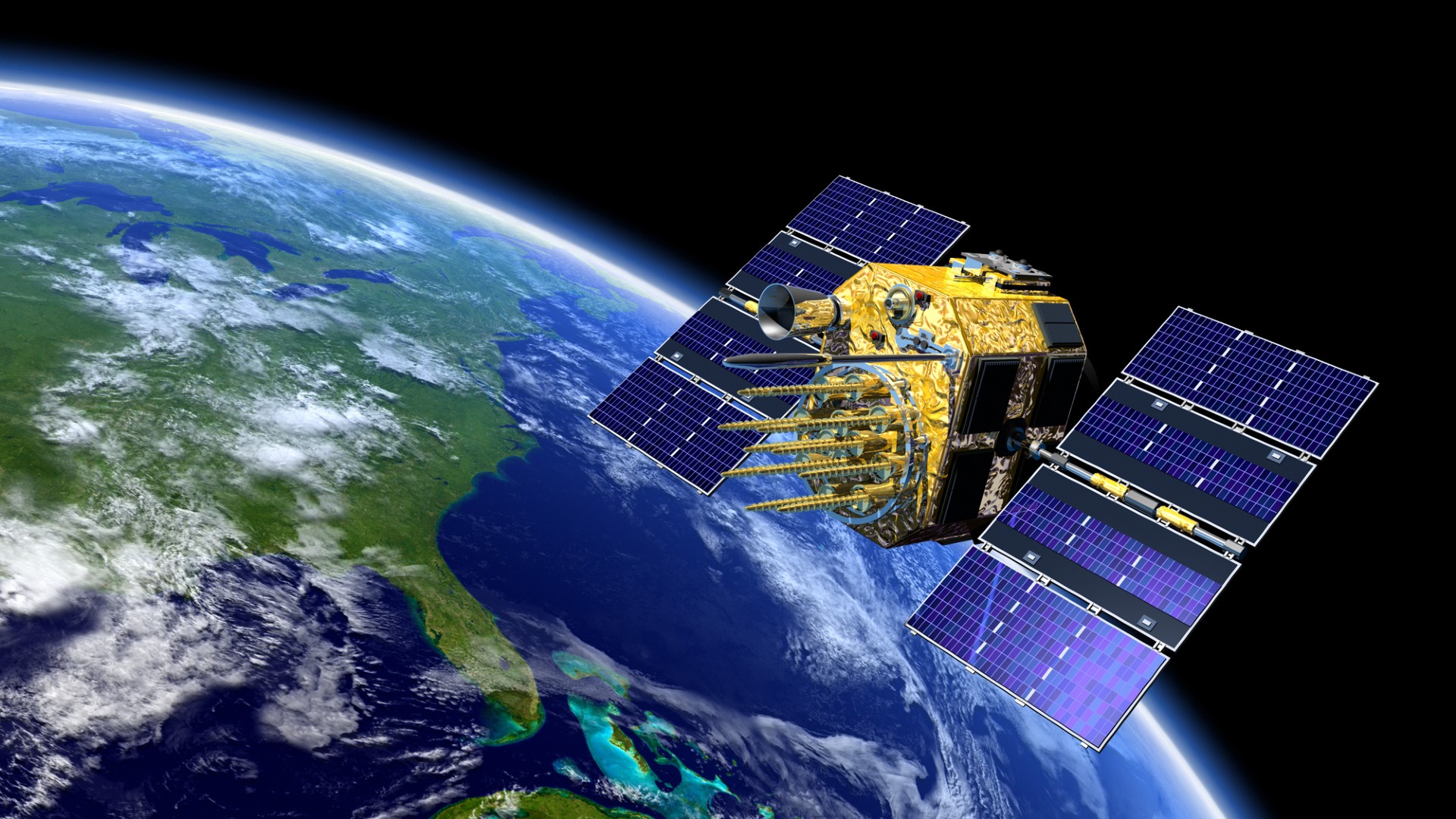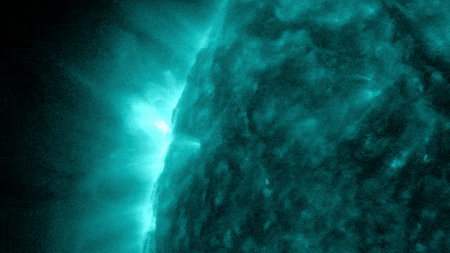GPS satellites threatened more by mild solar storms than monster sun flares
The most intense space weather event of the past two decades hit GPS satellites' orbit just after a solar minimum.

Mild solar storms can cause more serious problems to GPS satellites than once-in-a-century events, a new study has found.
Storms that erupt from the sun create challenges for satellites in Earth's orbit. Scientists are trying to understand these events better to help operators protect their spacecraft. And sometimes, they find surprises.
A new study by researchers from the British Antarctic Survey (BAS) discovered that satellites in the Global Positioning System (GPS) orbit may suffer more from milder solar storms than from the frightening events that wreak havoc on power grids and telecommunication networks on Earth.
Nigel Meredith, a BAS space weather research scientist, and his colleagues analyzed 20 years worth of satellite data and found that the most challenging incident for U.S. GPS spacecraft — which provide critical services for many sectors, including all kinds of transportation, banking and oil drilling — came from a minor solar storm in 2010, during a sleepy part of the sun's 11-year cycle of activity. And the most significant space weather event in recent history, the 2003 Halloween storm, left the GPS satellites orbiting 12,550 miles (20,200 kilometers) above Earth mostly unscathed.
"Sometimes people think that when there's a superstorm, everything's going to happen at once. But from our study, it shows that that's not necessarily the case," Meredith told Space.com. "We saw the largest fluxes [of energetic particles from the sun] during what, many people might say, was a benign storm."
Related: Wild solar weather is causing satellites to plummet from orbit. It's going to get worse.
Solar storms are caused by interactions of the charged particles that make up solar wind with Earth's magnetic field and our planet's atmosphere. Solar wind is a stream of ionized gas that constantly trickles from the sun. During vast eruptions of solar material known as coronal mass ejections (CME), the sun hurls huge quantities of this solar wind into space at once.
Get the Space.com Newsletter
Breaking space news, the latest updates on rocket launches, skywatching events and more!
Particles in the solar wind are magnetized, and when these huge plasma eruptions hit Earth's magnetic lines with the opposite magnetic pole, they temporarily disconnect the planet's protective magnetic shield and penetrate deep into the atmosphere. Reactions of the solar particles with atmospheric gases trigger colorful aurora displays but also induce electric currents that can, in the case of the most severe storms, knock out power grids and disrupt telecommunication networks.
There are several ways in which solar storms affect satellites. As solar wind particles mix with molecules of air, for example, the atmosphere warms up and swells, causing the density of the tenuous gases in the atmosphere's upper layers to increase. Spacecraft in low Earth orbit, including the International Space Station, suddenly experience more resistance and begin to lose altitude.

Killer electrons
Satellites at the GPS altitude suffer from a different effect of space weather. As the powerful bursts of solar wind breach Earth's magnetic field, the charged solar particles get trapped behind the planet's magnetic lines, injecting extra energy into Earth's outer radiation belt. In this region, which extends between altitudes of about 8,000 miles (13,000 kilometers) to 28,000 miles (45,000 km), concentrations of energetic particles are always quite high. A solar storm of the right strength can considerably heat things up, resulting in a dramatic increase in the number of "killer" electrons, electrons that are so energetic that they whizz around the planet every 10 minutes.
"[These electrons] have a very high energy. They can penetrate satellite surfaces, embed themselves in insulators and basically stay there," Meredith said. "Once they're in an insulator, the charge can build up over time, and then it can exceed the levels for a breakdown. You can have an electrostatic discharge, which can damage electronic components."
In some cases, the killer electrons can cause irreparable damage.
Operators can protect their spacecraft against these events by using hardened technologies or putting satellites into protective "safe mode," but that leads to service disruptions. Moreover, Meredith's research showed that the killer electrons may linger inside satellites long after the solar storm has passed.
"That's one reason why it's difficult to attribute [spacecraft] anomalies sometimes," said Meredith. "The charge can build up, and it can get to the point where it's nearly about to break down but doesn't actually break down. And then, a little bit later, a small event could come along and cause a discharge, although of course the majority of that charge would have come from the extreme event."
But why is the GPS orbit relatively safe during the most severe solar storms? Meredith said that the stronger the storm, the closer to the planet's surface the killer electrons accumulate. The most severe events, those that come once in 20 or 100 years, push the cloud of energetic particles toward lower orbital regions around 5,000 miles (8,000 km) above Earth. These regions are used, for example, by some telecommunication satellites, such as those of the O3b network.

Redundancy
Connie Dillon, the chief of public affairs at the U.S. Space Force Space Operations Command, which operates the GPS constellation, told Space.com in an email that, in addition to using the best available hardened, space-proven technology, the Space Force keeps GPS disruptions to a minimum by flying 13 more satellites than what is required for flawless service.
"The GPS constellation is nominally designed and operated with six orbital planes, with a minimum of four satellites per plane," Dillon wrote. "The 24-slot arrangement ensures users can view at least four satellites from virtually any point on the planet, but the Space Force flies 37 satellites to maintain coverage for whenever a baseline satellite becomes unserviceable."
There has never been "a solar weather event which has irreparably damaged a GPS satellite," and the Space Force is confident that the number of available redundant spacecraft would carry the critically important constellation even through the most severe solar storm, Dillon added.
The U.S. navigation and positioning constellation has been serving the world for more than 40 years. It may, however, soon be put through a test as the current solar cycle, the 25th since records began, is approaching its maximum. Contrary to earlier forecasts, the sun's activity is on a path to reach its highest levels in more than 20 years, and that will mean more solar wind hitting the planet and the satellites in its orbit.
Signal degraded
While the GPS constellation satellites might be protected from the vicious effect of killer electrons by thorough design, the signals these satellites emit to enable users on Earth to know their position might still suffer. As a result, powerful solar storms can render unreliable especially high-accuracy positioning services, such as those used in aviation.
The GPS satellite signals pass through Earth's atmosphere to reach receivers on the ground. On the way, these beams encounter the planet's ionosphere, a boundary between the atmosphere and the vacuum of outer space at altitudes of 50 to 400 miles (80 to 640 km). Here, the thin gases of the upper atmosphere get constantly lashed by intense sunlight, which leads to atoms ejecting electrons, turning the gas into ionized plasma. When solar flares and coronal mass ejections hit the planet, the ionosphere gets supercharged. Its properties change, which then affects how satellite signals propagate through this region.
"A satellite link may be degraded, or a link may be lost for a moment," Juha-Pekka Luntama, the head of space weather at the European Space Agency (ESA), told Space.com in an earlier interview. "So, if you have a GPS or GNSS [global navigation satellite system] receiver and you're looking at your position, if we have a solar event, the characteristics of the upper atmosphere change, then you will see a navigation error."
In your car's satnav system, the error may seem minor, like the location of a crossroad shown a dozen feet off, but systems used by aircraft to aid landing might become completely useless.
"If you're making a landing, and suddenly your navigation system has glitches, even if they are short term, it doesn't help," said Luntama. "As a pilot, you would like to know what's happening. Is your system failing? Is somebody intentionally trying to disturb you? Or is it just natural background noise?"
In most cases, such disruptions are rather short-lived, with systems back on within a few minutes. But during the most severe solar storms, disruptions can last much longer.
In February this year, a relatively mild solar storm forced Canadian oil-rig operators to suspend drilling for several hours as the GPS technology used to position their drill bits was showing unreliable readings.
"I've been a wellsite geologist for close to 30 years, and last night/this morning was the first time that we briefly suspended drilling operations due to a solar storm," Canadian exploration geologist Chris Mason said in a Facebook post at that time.
The storm that caused the February disruption was the strongest in years. Classed as a category 3 storm on the five-point scale developed by the U.S. National Oceanic and Atmospheric Administration (NOAA), the event surprised forecasters as it came on the heels of two relatively minor coronal mass ejections that received an extra boost from streams of fast solar wind flowing from a coronal hole, an opening in the sun's magnetic field.
Such coronal holes are the type of occurrence that might cause the most trouble in the GPS region, said Meredith, as they produce just about the right intensity of solar wind to energize particles farther away from Earth.
The current solar cycle is set to peak either in 2024 or 2025. That, however, doesn't mean that satellite operators will be able to relax two years from now. Some of the most lasting coronal holes have been documented to appear after a solar cycle peak, said Meredith.
The study was published on June 7 in the journal Space Weather.
Join our Space Forums to keep talking space on the latest missions, night sky and more! And if you have a news tip, correction or comment, let us know at: community@space.com.

Tereza is a London-based science and technology journalist, aspiring fiction writer and amateur gymnast. Originally from Prague, the Czech Republic, she spent the first seven years of her career working as a reporter, script-writer and presenter for various TV programmes of the Czech Public Service Television. She later took a career break to pursue further education and added a Master's in Science from the International Space University, France, to her Bachelor's in Journalism and Master's in Cultural Anthropology from Prague's Charles University. She worked as a reporter at the Engineering and Technology magazine, freelanced for a range of publications including Live Science, Space.com, Professional Engineering, Via Satellite and Space News and served as a maternity cover science editor at the European Space Agency.









